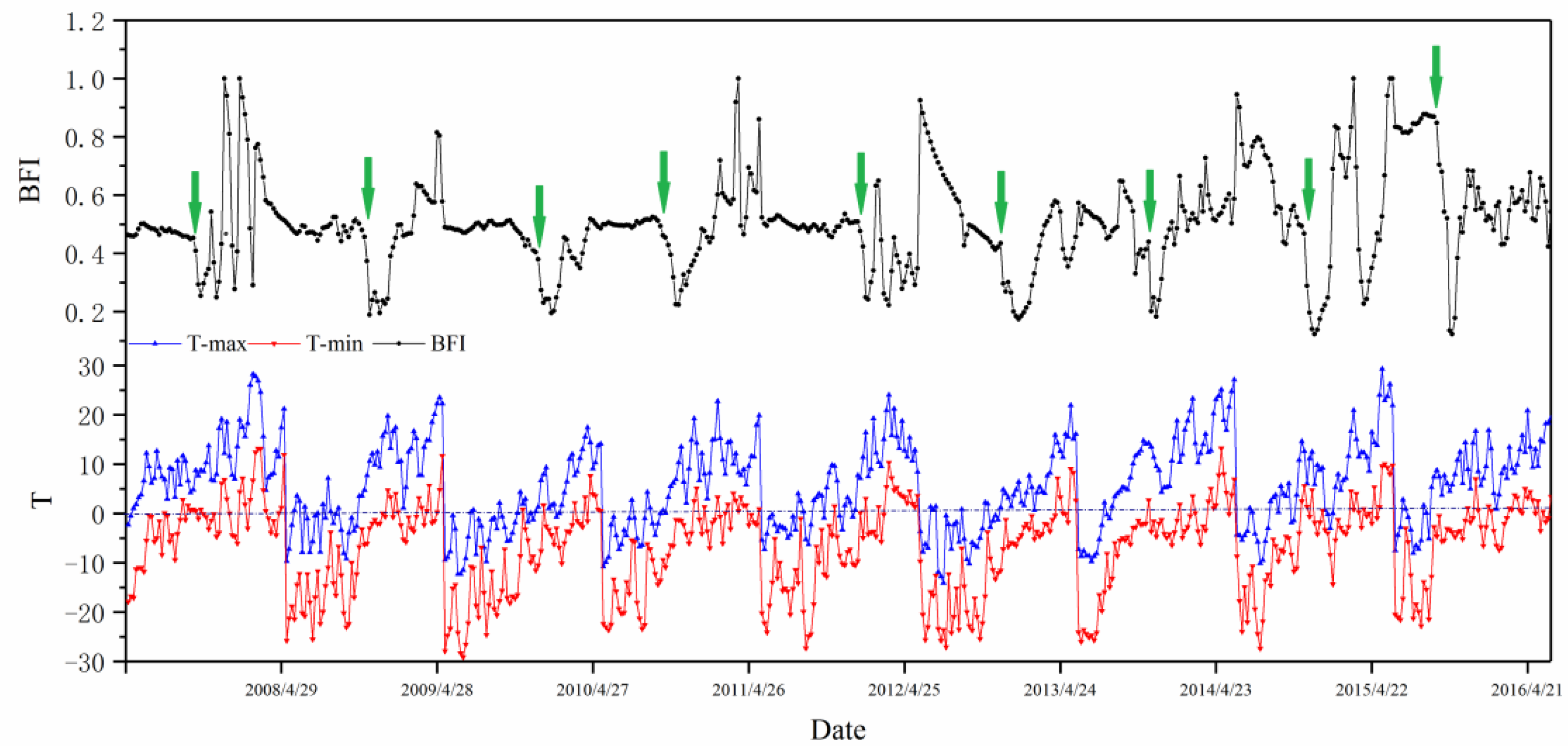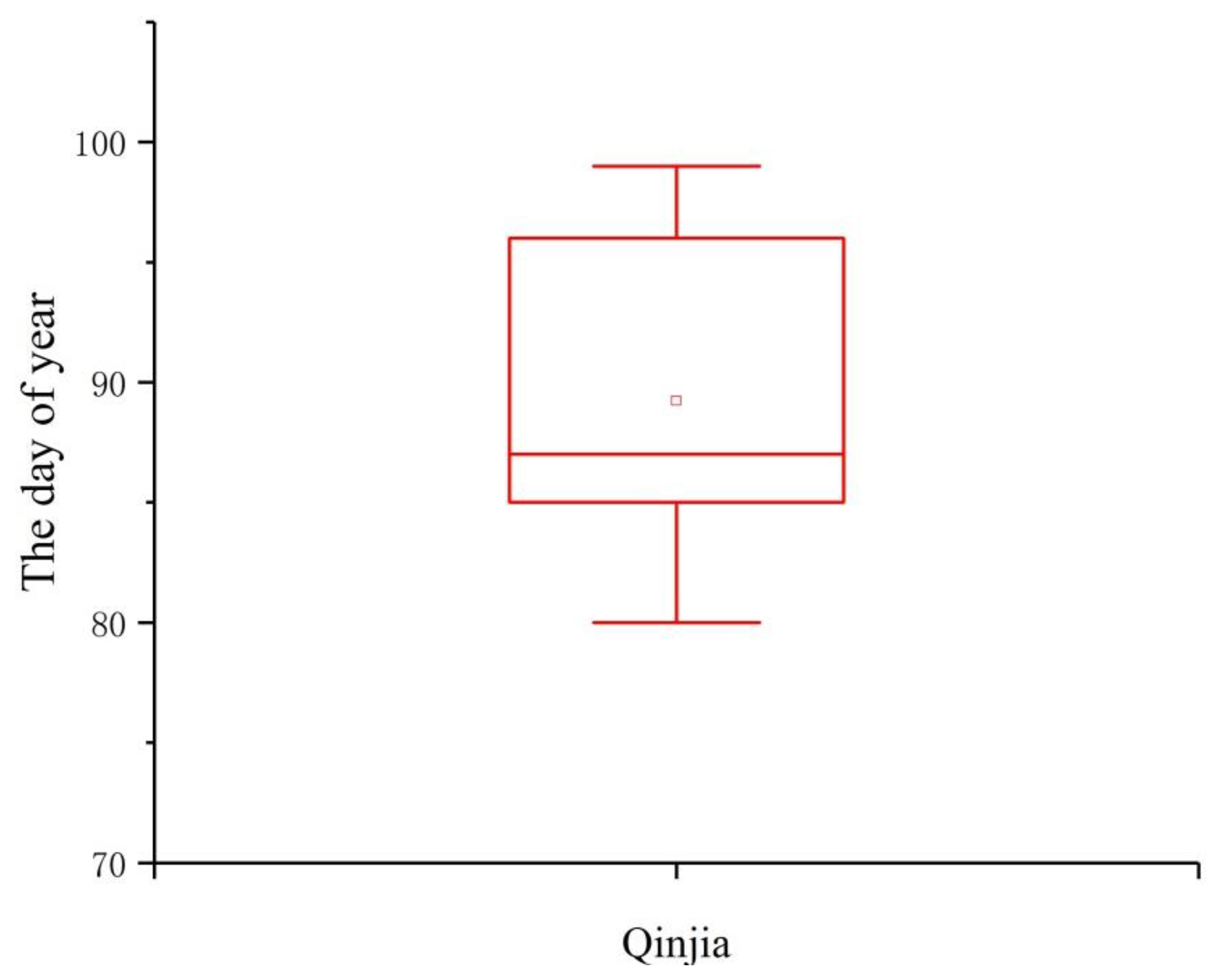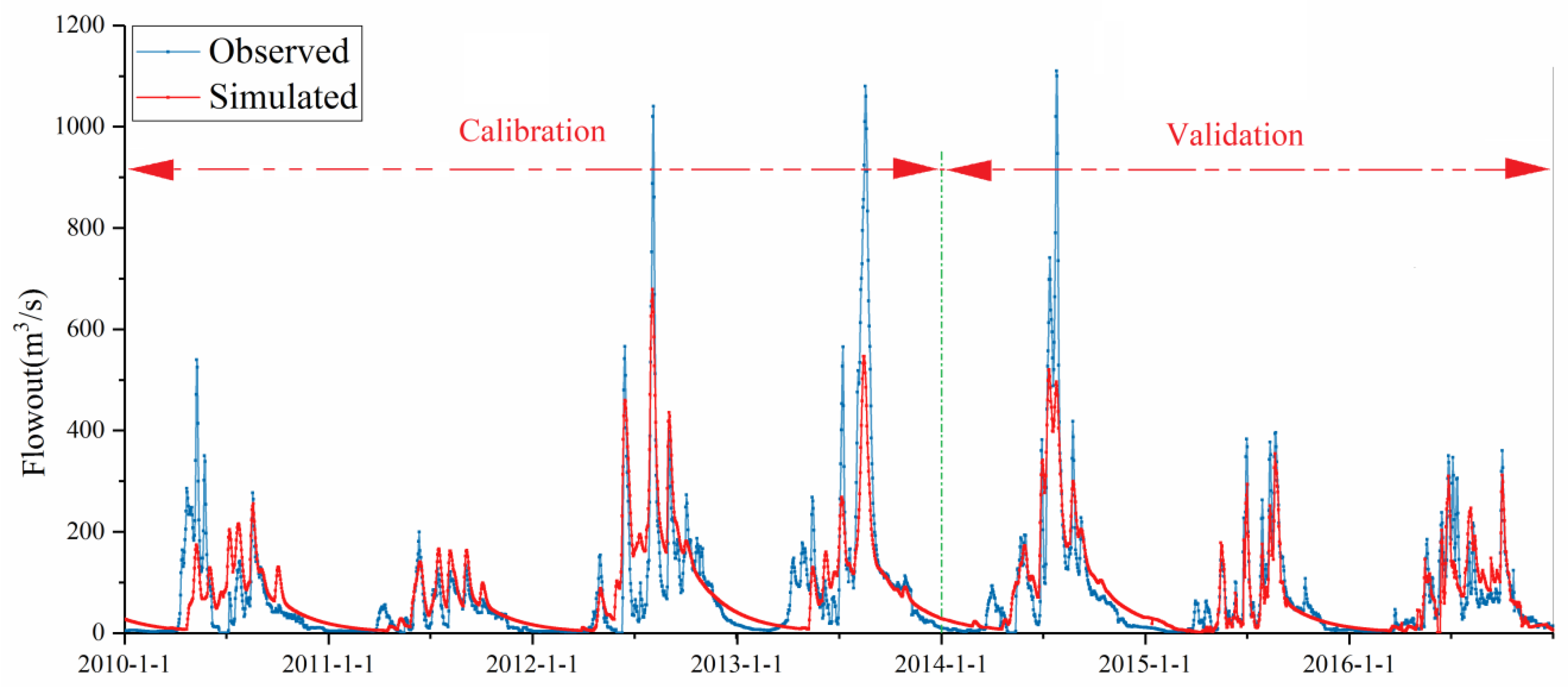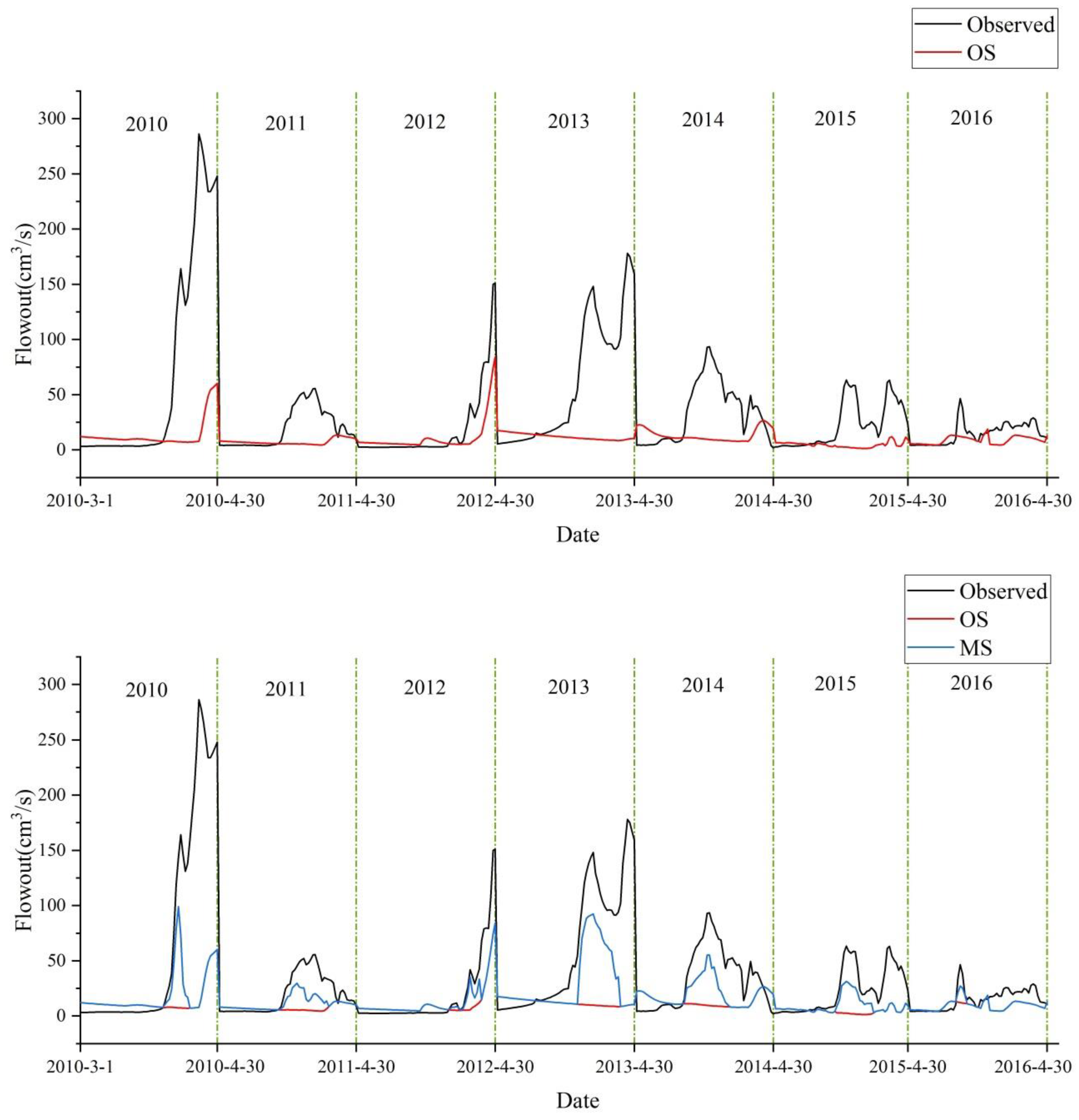Optimization and Application of Snow Melting Modules in SWAT Model for the Alpine Regions of Northern China
Abstract
:1. Introduction
2. Materials and Methods
2.1. Study Area
2.2. SWAT Model Description
2.3. SWAT Snow Melting Module Principle
2.3.1. The Snowpack
2.3.2. The Snowmelt
2.4. Model Modifications for the Snowmelt Runoff
2.4.1. Determination of the Snowmelt Runoff Period Based on Baseflow Segmentation
2.4.2. Modifying the Code of the Snow Melting Module of SWAT
2.5. Model Calibration and Validation
2.6. Statistical Evaluation
3. Results
3.1. Model Modification
3.2. Model Setup and Initial Simulation
3.3. Sensitivity Analysis
4. Discussion
4.1. Sensitivity Analysis
4.2. Calibration and Validation
4.3. Model Performance Assessment
4.4. Adequacy of the Modification
5. Conclusions
Author Contributions
Funding
Acknowledgments
Conflicts of Interest
References
- Flanagan, D.C.; Nearing, M.A. USDA-Water Erosion Prediction Project: Hillslope Profile and Watershed Model Documentation. NSERL Report 10; USDA-ARS National Soil Erosion Research Laboratory: West Lafayette, IN, USA, 1995.
- Wang, X.; Melesse, A.M. Evaluation of the Swat Model’s Snowmelt Hydrology in a Northwestern Minnesota Watershed. Trans. Asae 2005, 48, 1359. [Google Scholar] [CrossRef]
- Zeinivand, H.; Smedt, F.D. Hydrological modeling of snow accumulation and melting on river basin scale. Water Resour. Manag. 2009, 23, 2271–2287. [Google Scholar] [CrossRef]
- Shen, Y.J.; Shen, Y.; Fink, M.; Kralisch, S.; Chen, Y.; Brenning, A. Trends and variability in streamflow and snowmelt runoff timing in the southern Tianshan Mountains. J. Hydrol. 2018, 557, 173–181. [Google Scholar] [CrossRef]
- Li, H.Y.; Wang, Y.X.; Jia, L.N.; Wu, Y.N.; Xie, M. Runoff characteristics of the Nen River Basin and its cause. J. Mt. Sci. 2014, 11, 110–118. [Google Scholar] [CrossRef]
- Tuo, Y.; Marcolini, G.; Disse, M.; Chiogna, G. Calibration of snow parameters in SWAT: Comparison of three approaches in the Upper Adige River basin (Italy). Hydrol. Sci. J. 2018, 63, 657–678. [Google Scholar]
- Debele, B.; Srinivasan, R.; Gosain, A. Comparison of process-based and temperature-index snowmelt modeling in SWAT. Water Resour. Manag. 2010, 24, 1065–1088. [Google Scholar] [CrossRef]
- USGS. Precipitation Runoff Modeling System (PRMS); John Wiley & Sons, Ltd.: Hoboken, NJ, USA, 1983; pp. 206–207.
- Band, L.E.; Patterson, P.; Nemani, R.; Running, S.W. Forest ecosystem processes at the watershed scale: Incorporating hillslope hydrology. Agric. For. Meteorol. 1993, 63, 93–126. [Google Scholar] [CrossRef] [Green Version]
- Wood, E.F.; Lettenmaier, D.P.; Zartarian, V.G. A Land Surface Hydrology Parameterization with Sub-Grid Variability for General Circulation Models. J. Geophys. Res. D 1992, 97, 2717–2728. [Google Scholar] [CrossRef]
- Gassman, P.W.; Sadeghi, A.M.; Srinivasan, R. Applications of the SWAT model special section: Overview and insights. J. Environ. Qual. 2014, 43, 1–8. [Google Scholar] [CrossRef]
- Douglasmankin, K.R.; Srinivasan, R.; Arnold, J.G. Soil and Water Assessment Tool (SWAT) Model: Current Developments and Applications. ASABE 2010, 53. [Google Scholar] [CrossRef]
- Gassman, P.W.; Reyes, M.R.; Green, C.H.; Arnold, G.J. The Soil and Water Assessment Tool: Historical Development, Applications, and Future Research Directions. Trans. ASABE 2007, 50, 1211–1250. [Google Scholar] [CrossRef] [Green Version]
- Lévesque, É.; Anctil, F.; Griensven, A.V.; Beauchamp, N. Evaluation of streamflow simulation by SWAT model for two small watersheds under snowmelt and rainfall. Hydrol. Sci. J. 2008, 53, 961–976. [Google Scholar]
- Arnold, J.G.; Srinivasan, R.; Muttiah, R.S.; Williams, J.R. Large area hydrologic modeling and assessment part I: Model development. Jawra J. Am. Water Resour. Assoc. 1998, 34, 73–89. [Google Scholar] [CrossRef]
- Wang, X.; Melesse, A.M. Effects of Statsgo and Ssurgo as Inputs on Swat Model’s Snowmelt Simulation 1. Jawra J. Am. Water Resour. Assoc. 2006, 42, 1217–1236. [Google Scholar] [CrossRef]
- Bouraoui, F.; Grizzetti, B. Modelling mitigation options to reduce diffuse nitrogen water pollution from agriculture. Sci. Total Environ. 2014, 468, 1267–1277. [Google Scholar] [CrossRef]
- Chen, Y.; Marek, G.; Marek, T.; Brauer, D.; Srinivasan, R. Improving SWAT auto-irrigation functions for simulating agricultural irrigation management using long-term lysimeter field data. Environ. Model. Softw. 2018, 99, 25–38. [Google Scholar] [CrossRef]
- Wu, Y.; Liu, J.; Shen, R.; Fu, B. Mitigation of nonpoint source pollution in rural areas: From control to synergies of multi ecosystem services. Sci. Total Environ. 2017, 607, 1376–1380. [Google Scholar] [CrossRef]
- Francesconi, W.; Srinivasan, R.; Pérez-Miñana, E.; Willcock, S.P.; Quintero, M. Using the Soil and Water Assessment Tool (SWAT) to model ecosystem services: A systematic review. J. Hydrol. 2016, 535, 625–636. [Google Scholar] [CrossRef]
- Golmohammadi, G.; Rudra, R.; Dickinson, T.; Goel, P.; Veliz, M. Predicting the temporal variation of flow contributing areas using SWAT. J. Hydrol. 2017, 547, 375–386. [Google Scholar] [CrossRef]
- Liu, R.; Xu, F.; Zhang, P.; Yu, W.; Men, C. Identifying non-point source critical source areas based on multi-factors at a basin scale with SWAT. J. Hydrol. 2016, 533, 379–388. [Google Scholar] [CrossRef]
- Malagò, A.; Efstathiou, D.; Bouraoui, F.; Nikolaidis, N.P.; Franchini, M.; Bidoglio, G.; Kritsotakis, M. Regional scale hydrologic modeling of a karst-dominant geomorphology: The case study of the Island of Crete. J. Hydrol. 2016, 540, 64–81. [Google Scholar] [CrossRef]
- Wang, Y.; Bian, J.; Wang, S.; Tang, J.; Ding, F. Evaluating SWAT Snowmelt Parameters and Simulating Spring Snowmelt Nonpoint Source Pollution in the Source Area of the Liao River. Pol. J. Environ. Stud. 2016, 25. [Google Scholar] [CrossRef]
- Fontaine, T.A.; Cruickshank, T.S.; Arnold, J.G.; Hotchkiss, R.H. Development of a snowfall–snowmelt routine for mountainous terrain for the soil water assessment tool (SWAT). J. Hydrol. 2002, 262, 209–223. [Google Scholar] [CrossRef]
- Qi, J.; Li, S.; Jamieson, R.; Hebb, D.; Xing, Z.; Meng, F.-R. Modifying SWAT with an energy balance module to simulate snowmelt for maritime regions. Environ. Model. Softw. 2017, 93, 146–160. [Google Scholar] [CrossRef]
- Holvoet, K.; Griensven, A.V.; Gevaert, V.; Seuntjens, P.; Vanrolleghem, P.A. Modifications to the SWAT code for modelling direct pesticide losses. Environ. Model. Softw. 2008, 23, 72–81. [Google Scholar] [CrossRef]
- Aksoy, H.; Kurt, I.; Eris, E. Filtered smoothed minima baseflow separation method. J. Hydrol. 2009, 372, 94–101. [Google Scholar] [CrossRef]
- Nathan, R.J.; McMahon, T.A. Evaluation of automated techniques for baseflow and recession analyses. Water Resour. Res. 1990, 26, 1465–1473. [Google Scholar] [CrossRef]
- Sloto, R.A.; Crouse, M.Y. HYSEP, A Computer Program for Streamflow Hydrograph Separation and Analysis; U.S. Geological Survey: Reston, VA, USA, 1996.
- Arnold, J.G.; Moriasi, D.N.; Gassman, P.W.; Abbaspour, K.C.; White, M.J.; Srinivasan, R.; Santhi, C.; Harmel, R.D.; Griensven, A.V.; Liew, M.W.V. SWAT: Model use, calibration, and validation. Trans. Asabe 2012, 55, 1549–1559. [Google Scholar] [CrossRef]
- Neitsch, S.; Arnold, J.; Kiniry, J.; Srinivasan, R.; Williams, J. Soil and water assessment tool user’s manual version 2000. Gsl. Rep. 2002, 202, 2–6. [Google Scholar]
- Srinivasan, R.; Zhang, X.; Arnold, J. SWAT ungauged: Hydrological budget and crop yield predictions in the Upper Mississippi River Basin. Trans. Asabe 2010, 53, 1533–1546. [Google Scholar] [CrossRef]
- Holzworth, D.P.; Snow, V.; Janssen, S.; Athanasiadis, I.N.; Donatelli, M.; Hoogenboom, G.; White, J.W.; Thorburn, P. Agricultural production systems modelling and software: Current status and future prospects. Environ. Model. Softw. 2015, 72, 276–286. [Google Scholar] [CrossRef]
- Abbaspour, K.C. SWAT-CUP 2012: SWAT Calibration and Uncertainty Programs—A User Manual; Eawag: Dübendorf, Switzerland, 2013. [Google Scholar]
- Dhami, B.; Himanshu, S.K.; Pandey, A.; Gautam, A.K. Evaluation of the SWAT model for water balance study of a mountainous snowfed river basin of Nepal. Environ. Earth Sci. 2018, 77, 21. [Google Scholar] [CrossRef]
- Nash, J.E.; Sutcliffe, J.V. River flow forecasting through conceptual models part I—A discussion of principles. J. Hydrol. 1970, 10, 282–290. [Google Scholar] [CrossRef]
- Moriasi, D.N.; Arnold, J.G.; Liew, M.W.V.; Bingner, R.L.; Harmel, R.D.; Veith, T.L. Model Evaluation Guidelines for Systematic Quantification of Accuracy in Watershed Simulations. Trans. Asabe 2007, 50, 885–900. [Google Scholar] [CrossRef]
- Singh, V.; Bankar, N.; Salunkhe, S.S.; Bera, A.K.; Sharma, J. Hydrological stream flow modelling on Tungabhadra catchment: Parameterization and uncertainty analysis using SWAT CUP. Curr. Sci. 2013, 104, 1187–1199. [Google Scholar]






| N Total | Mean | Standard Deviation | Sum | Minimum | Median | Maximum |
|---|---|---|---|---|---|---|
| 9 | 89 | 6.667 | 803 | 80 | 89 | 99 |
| Data | Range Accuracy | Data Sources |
|---|---|---|
| Digital elevation model | STRM 90 m | http://www.gscloud.cn/ |
| Soil maps | 1:1000000 | Harmonized world soil database |
| Land use/cover | 1:100000 | http://www.resdc.cn/data.aspx?DATAID=99 |
| Weather data | CMADS (2008–2016) | http://westdc.westgis.ac.cn |
| Runoff | 2008–2016 | Hydrographic office |
| Parameter_Name | File | Physical Significance | Range | Unit |
|---|---|---|---|---|
| CN2 | mgt | SCS runoff curve number | 35–98 | dimensionless |
| ALPHA_BF | gw | Baseflow alpha factor | 0–1 | days |
| GW_DELAY | gw | Groundwater delay | 0–500 | days |
| GWQMN | gw | Threshold depth of water in the shallow aquifer required for return flow to occur | 0–5000 | mm H2O |
| GW_REVAP | gw | Groundwater “revap” coefficient | 0.02–0.2 | dimensionless |
| REVAPMN | gw | Threshold depth of water in the shallow aquifer for “revap” to occur | 0–500 | mm H2O |
| ESCO | hru | Soil evaporation compensation factor | 0–1 | dimensionless |
| CANMX | hru | Maximum canopy storage | 0–100 | mm H2O |
| SLSUBBSN | hru | Average slope length | 10–150 | m |
| SOL_K(..) | sol | Saturated hydraulic conductivity | 0–2000 | mm/hr |
| SOL_BD(..) | sol | Moist bulk density | 0.9–2.5 | g/cm3 |
| SOL_AWC(..) | sol | Available water capacity of the soil layer | 0–1 | mm H2O/mm soil |
| ALPHA_BNK | rte | Baseflow alpha factor for bank storage | 0–1 | days |
| CH_K2 | rte | Effective hydraulic conductivity in main channel alluvium | −500.01 | mm/hr |
| CH_N2 | rte | Manning’s “n” value for the main channel | −0.31 | dimensionless |
| SFTMP | bsn | Snowfall temperature | −40 | °C |
| SMTMP | bsn | Snow melt base temperature | −40 | °C |
| SMFMX | bsn | Maximum melt rate for snow during year (occurs on summer solstice) | 0–20 | mm H2O/°C day |
| TIMP | bsn | Snowpack temperature lag factor | 0–1 | dimensionless |
| SNOCOVMX | bsn | Minimum snow water content that corresponds to 100% snow cover | 0–500 | mm H2O |
| SMFMN | bsn | Minimum melt rate for snow during the year (occurs on winter solstice) | 0–20 | mm H2O/°C day |
| SNO50COV | bsn | Minimum snow water content that corresponds to 50% snow cover | 0–500 | dimensionless |
| Parameter_Name | file | Assignment | Fitted_Value | Unit |
|---|---|---|---|---|
| CN2 | mgt | v | 35.2326 | dimensionless |
| ALPHA_BF | gw | v | 0.502689 | days |
| GW_DELAY | gw | v | 65.853645 | days |
| GWQMN | gw | v | 841.039673 | mm H2O |
| GW_REVAP | gw | v | 0.098768 | dimensionless |
| REVAPMN | gw | v | 54.239353 | mm H2O |
| ESCO | hru | v | 0.157893 | dimensionless |
| CANMX | hru | v | 41.954502 | mm H2O |
| SLSUBBSN | hru | v | 42.100601 | m |
| SOL_K(..) | sol | v | 1785.92395 | mm/hr |
| SOL_BD(..) | sol | v | 1.465848 | g/cm3 |
| SOL_AWC(..) | sol | v | −0.101126 | mm H2O/mm soil |
| ALPHA_BNK | rte | v | 0.503674 | days |
| CH_K2 | rte | v | 344.855682 | mm/hr |
| CH_N2 | rte | v | 0.219884 | dimensionless |
| SFTMP | bsn | v | 4.236598 | °C |
| SMTMP | bsn | v | 8.508638 | °C |
| SMFMX | bsn | v | 6.828101 | mm H2O/°C day |
| TIMP | bsn | v | 0.545052 | dimensionless |
| SNOCOVMX | bsn | v | 79.400223 | mm H2O |
| SMFMN | bsn | v | 15.326536 | mm H2O/°C day |
| SNO50COV | bsn | v | 0.5 | dimensionless |
| Annual | Mode Evaluation Statistics | Original | Modification | ||
| Calibration (2010–2013) | Validation (2014–2016) | Calibration (2010–2013) | Validation (2014–2016) | ||
| NSE | 0.6926 | 0.70243 | 0.70253 | 0.813204 | |
| R2 | 0.7661 | 0.785 | 0.784 | 0.791 | |
| PBIAS | −0.01732 | 0.0206 | −0.03299 | 0.011 | |
| Snowmelt from March to April | Mode Evaluation Statistics | Original | Modification | ||
| Calibration (2010–2013) | Validation (2014–2016) | Calibration (2010–2013) | Validation (2014–2016) | ||
| NSE | −0.09896 | −3.396 | 0.141611 | 0.207441 | |
| R2 | 0.225 | 0.013 | 0.347 | 0.231 | |
| PBIAS | 0.73338 | 0.620122 | 0.557087 | 0.443954 | |
© 2020 by the authors. Licensee MDPI, Basel, Switzerland. This article is an open access article distributed under the terms and conditions of the Creative Commons Attribution (CC BY) license (http://creativecommons.org/licenses/by/4.0/).
Share and Cite
Liu, Y.; Cui, G.; Li, H. Optimization and Application of Snow Melting Modules in SWAT Model for the Alpine Regions of Northern China. Water 2020, 12, 636. https://doi.org/10.3390/w12030636
Liu Y, Cui G, Li H. Optimization and Application of Snow Melting Modules in SWAT Model for the Alpine Regions of Northern China. Water. 2020; 12(3):636. https://doi.org/10.3390/w12030636
Chicago/Turabian StyleLiu, Yan, Geng Cui, and Hongyan Li. 2020. "Optimization and Application of Snow Melting Modules in SWAT Model for the Alpine Regions of Northern China" Water 12, no. 3: 636. https://doi.org/10.3390/w12030636
APA StyleLiu, Y., Cui, G., & Li, H. (2020). Optimization and Application of Snow Melting Modules in SWAT Model for the Alpine Regions of Northern China. Water, 12(3), 636. https://doi.org/10.3390/w12030636




